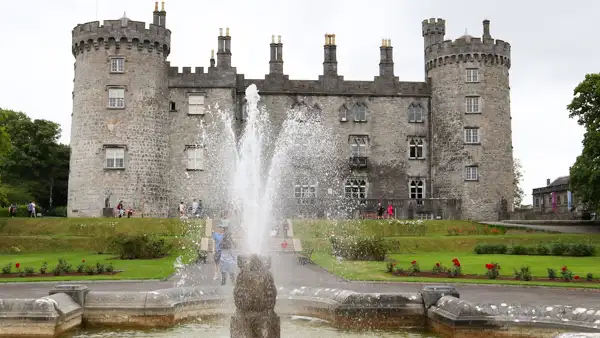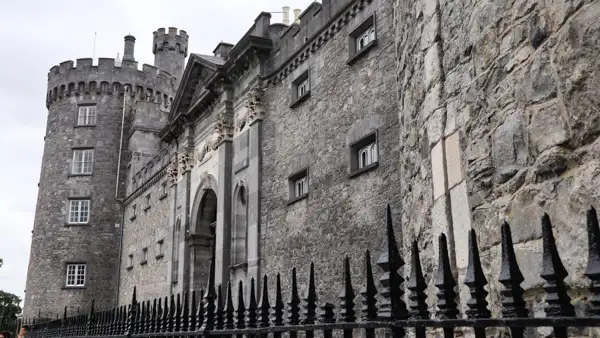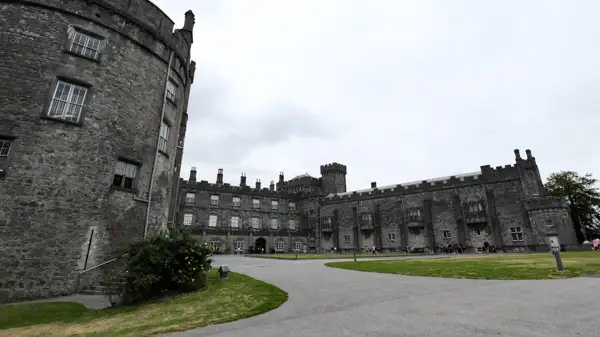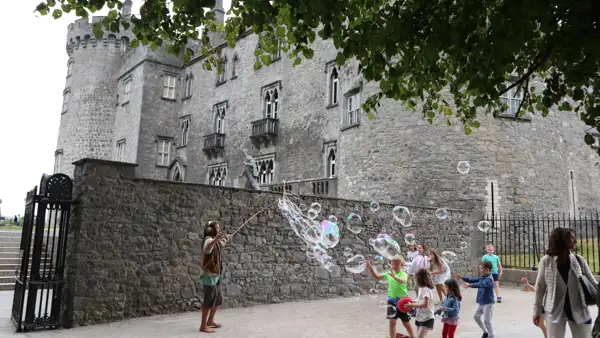How do you explain such a beautiful and famous castle and do it justice? I will give it a try and tell you about Isabel and Elizabeth….
Page Contents (click line to jump the text)

Intro
This castle is a gem on the island of Ireland, which is blessed with a wealth of castles.
We live not far from it and I have visited it several times, both inside and out. And yet I still find it difficult to write about it.
But let’s start a little further ahead: My family and I are from Germany, but have lived in Ireland for several years (second home) now. We have been to Kilkenny a number of times.
The castle towers majestically over the River Nore.
Its appearance is somewhat strange, as it is partly reminiscent of the medieval fortress it once was and partly of a residential and representative castle or chateau, which it once was, too.
But whether it’s a chateau, a castle or a fortress, here it is simply called a “castle”.
Let’s jump back in time to discover the secrets of Kilkenny Castle:
Richard Strongbow and the beginnings of Kilkenny
Rivers have always been and still are natural trade routes and natural obstacles at the same time. And so it is no wonder that settlements have sprung up in many places where the river can be crossed. Fortified forts monitor the trade routes, settlements become smaller and larger towns and wooden forts become castles. In simple terms, this is the typical history of the development of many towns in Europe.
This is also what happened here: The River Nore has long been used as a trade route. The shallow ford across the river made it possible for travellers to pass by land. There had probably been simple settlements here for a very long time, when nobody had any idea of a castle being built.
Then a storm arose. This time not from the west, but from France: The Normans conquered England and later, by now they were Anglo-Normans, they also came to Ireland.

The Norman nobleman Richard de Clare, 2nd Earl of Pembroke, was commissioned by King Henry II in 1170 to support the Irish King Dermot McMurrough against Irish rebels. He was actually only part-king of the southern province of Leinster, but it was an enormous province.
Richard probably did his job so well that he was given the illustrious nickname “Strongbow” and was even allowed to marry Dermot’s daughter, Aoife – the brave knight gets the princess – just like in a fairy tale!
Strongbow was also awarded parts of the lands he conquered, such as here, in what is now County Kilkenny, where he had a wooden fortification built on the banks of the River Nore, which probably marked the origin of Kilkenny Castle.
Knight William and the brave Isabel – the dynasty of the Earls of Pembroke
The tale of Richard Strongbow and the Irish princess Aoife was soon followed by a girl named Isabel.
She later married William Marshal, an Anglo-Norman and recognised good knight and Marshal of England, who had fought against the Saracens on the Crusades for several years. Isabel brought in lands in Wales (Pembroke) and Ireland (Leinster) and the marriage and William confusingly became the 1st Earl of Pembroke (Wales).
In Pembroke, the title of Earl was not bequeathed to him, but reassigned, and so he again became 1st Earl of Pembroke (Wales), although his father-in-law and predecessor had already been 2nd Earl of Pembroke.

In Leinster, William, who was an experienced knight, had a stone castle built on the banks of the River Nore. His father-in-law’s wooden fortification on the same site had long since been destroyed by rebels. The new castle is built according to the Norman model, with four round towers and high walls, as well as several nested forecourts for defence.
The town in front of the castle was also fortified for the first time with stone walls and gates and was granted town charter in 1207.
When Knight William was out of the country, Kilkenny Castle was besieged. But the attackers had not reckoned with the courageous determination of his wife Isabel. Pregnant, she commands the defence and is so successful that she is able to fend off the siege and capture numerous attackers.
Isabel’s subsequent punishment of the prisoners must have been so severe that the returning William even had the sentences mitigated to prevent worse executions. The lady was obviously really angry!
Turbulent times and the wise Elizabeth – The dynasty of the Earls of Ormond
In 1391, the castle and its lands were not passed down in the line of the Marshals and Earls of Pembroke.
Instead, the English Crown collected the inheritance and sold the castle and land to an influential Anglo-Norman nobleman, James Butler, the 3rd Earl of Ormond. From then on, the Butler family ruled the surrounding area for decades.
In the 17th century, Irish insurgents rebelled against English rule. They also made use of Kilkenny Castle and used it as the centre of the rebellion for several years.
At the time, the castle belonged to Elizabeth Preston, the wife of the royalist James Butler. Whilst the unpopular landlord was usually away in Dublin, his clever wife ensured that Kilkenny was managed and maintained with a great deal of diplomacy and numerous letters to powerful people of the time.

In 1650, Oliver Cromwell marched from England to Ireland with his troops and quickly put an end to the uprisings. He besieged not only Kilkenny, but also numerous other castles and towns. They all fell, including Kilkenny in 1650.
James Butler, 1st Duke of Ormond, had lost to Cromwell. Not only in previous battles near Dublin, but also, in absentia represented by a relative, in Kilkenny.
It was thanks to his clever wife Elizabeth that the Butler family finally regained at least some of their possessions and were able to return from exile. She had obviously impressed Cromwell with her letters.
In the period that followed, the partially damaged castle was partially rebuilt and extended from a fortress to a representative palace and experienced its heyday over the next 150 years or so.
Kilkenny Castle today
Three hundred years later: the once wealthy Butler family is impoverished, Kilkenny Castle is dilapidated and in 1967 Arthur Butler sells the castle and park to the city of Kilkenny – for a symbolic 50 pounds.
The tour of the castle, which is well worth seeing, includes photos of what the castle looked like back then – unimaginable.
Today, the castle belongs to the Office of Public Works, which has invested an incredible amount of time, labour and attention to detail to restore Kilkenny Castle to its former glory.

Top renovated and beautifully furnished, with magnificent rooms, fantastic tapestries and an impressive collection of paintings, it takes you back to the splendour of the 17th and early 18th centuries, but has not forgotten its medieval roots.
The castle park around the castle is freely accessible, the guided tour inside costs a small entrance fee. You will find the opening hours and prices here: https://kilkennycastle.ie/tickets-and-times/
Incidentally, you can still see and read the letters of the clever Elizabeth in the exhibition at Kilkenny Castle.
Conclusion
Kilkenny Castle is not just another pile of stones – it is a very beautiful castle with a chequered and interesting history.
You should walk around the castle at least once and enjoy the castle park with its view over the river.
Better still, take the beautiful one-hour guided tour of the castle.
Even better: spend a night in Kilkenny and enjoy the beautiful city – but there will be a separate article about that.
I wish you lots of fun in Kilkenny!
More interesting articles for you
THE MEDIEVAL TOWN OF KILKENNY
THE REBELLIOUS TOWN OF ENNISCORTHY
CAHIR CASTLE – A STAR AMONG THE CASTLES
Picture credits cover picture: Statue in the gardens of Kilkenny Castle, photo by Ulrich Knüppel-Gertberg (www.irland-insider.de, www.ireland-insider.com)